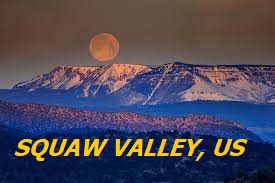Why Squaw Valley is Being Renamed – Understanding the Controversy
Why Squaw Valley is being renamed? Through this blog article, let’s understand the controversy. Squaw Valley’s renaming is part of a larger national campaign to confront historical injustices and advance more fairness and social justice for underrepresented groups. It serves as a reminder of the influence language has as well as the value of appreciating and respecting the various cultures and histories that go into the making of our society. Squaw Valley’s rebranding has generated debate. Few locals and frequent tourists to the region expressed sadness and annoyance at the removal of a well-known moniker.
Many others, however, have embraced the modification because they view it as a significant step in the direction of more cultural awareness and inclusion.
Where exactly is the Squaw Valley Located?
Squaw Valley is a little community in California’s Placer County.
It is most known as the location of the 1960 Winter Olympics.
This attracted interest from around the world and helped establish the region as a premier skiing destination.
Squaw Valley’s history begins in the middle of the 19th century when cattle used it as a summer grazing area.
A tiny resort was built nearby in the late 1800s, primarily for affluent San Franciscans searching for a cool mountain escape.
A historic and action-packed vacation spot is Squaw Valley, California.
This little town in the Sierra Nevada Mountains is well-known as a top skiing destination worldwide,
in part because it served as the venue for the 1960 Winter Olympics.
Squaw Valley, however, is a year-round destination that provides a variety of activities for guests of all ages and interests.
It is more than just a ski resort.
Geographical Location

SQUAW VALLEY IN CALIFORNIA, US
Squaw Valley is a small community in the western US state of California’s Placer County.
Around 200 miles east of San Francisco and 50 miles west of Reno, Nevada, it is located in the Sierra Nevada mountains.
The town has a total area of around 3.9 square miles and is situated at an elevation of 6,200 feet (1,890 meters) above sea level (10.1 sq. Km).
Some of the most breathtaking natural beauty in the country surrounds Squaw Valley.
The Sierra Nevada mountains, which dominate the region, provide stunning views of snow-capped mountains, deep valleys, and beautiful
lakes.
The settlement is situated in the Truckee River watershed, a significant Sacramento River tributary, and an important source of water for
much of California.
PRAIRIES GRASSLAND ECOSYSTEM – The Climate and Geography that make this region so distinctive.
Climate
Winters in Squaw Valley are chilly and snowy, and summers are pleasant and bright.
One of the snowiest places in the United States, the area typically receives 450 inches (1,140 cm) of snow per year.
Summers are typically mild and dry, with daytime highs of around 70 degrees Fahrenheit (21Degree Celcius)
Despite being far away, Squaw Valley is simple to get to by car because Interstate 80 is only a few miles to the north of the town.
The Reno-Tahoe International Airport is only 45 minutes to the east and offers air service to the region.
Once in Squaw Valley, tourists can use a variety of trails and beautiful roadways.
You can explore the area on foot, by bike, or by car.
With a range of trails and scenic drives winding through the surrounding mountains and valleys.
If the US Can Have Six, Why Can’t India Have Two-Time Zones?
What makes it special?

The history of Squaw Valley is one of the factors that makes it such a unique location.
From the middle of the 19th century, the region has served as a summer grazing place for cattle.
In the late 1800s, a modest resort was built to serve wealthy San Franciscans looking for a cool mountain refuge.
But Squaw Valley’s genuine ski resort growth did not start until the 1940s.
The accessibility of Squaw Valley is among its outstanding features.
It is not far from Lake Tahoe, one of the most stunning and well-liked tourist spots in the country.
Also, due to its location in the Sierra Nevada mountains, anyone who visits can take in the breathtaking scenery at any time of year.
Squaw Valley offers something to offer everyone.
whether they are skiers, hikers, nature lovers, or just searching for a lovely and tranquil retreat.
It is a place that every traveler should include on their bucket list because of its fascinating history, first-rate amenities, and breathtaking
natural beauty.
Why not schedule your trip today and discover Squaw Valley’s enchantment for yourself?
The Fascinating History Of The Appalachian mountains
SQUAW VALLEY: THE HOST OF THE 1960 WINTER OLYMPICS
A young businessman by the name of Alex Cushing visited Squaw Valley in 1949 and saw the possibility of a ski resort.
He invested the ensuing years in acquiring land and creating the infrastructure required to become a premier skiing resort.
With only two lifts and a few runs when it was opened in 1949, the resort immediately gained appeal.
When Squaw Valley was chosen in 1955 to host the Winter Olympics.
After that, it underwent a transformation and was elevated to a global level.
The Olympic Games were a big success and contributed to Squaw Valley being one of the world’s top skiing locations.
In the years that followed, the resort kept growing, adding additional lifts, runs, and services.
The resort continued to expand in the years that followed, with new lifts, runs, and amenities added to accommodate the growing number of
visitors
Squaw Valley is now a part of the larger resort complex known as Squaw Valley Alpine Meadows, which includes two distinct ski areas and
provides tourists with a variety of winter and summer activities.
Despite major changes since its beginnings as a summer grazing area, the region is still a favorite vacation spot for skiers and outdoor
enthusiasts from all over the world.
The 1960 Winter Olympics were a great success and contributed to Squaw Valley becoming a top-tier ski resort.
But the region’s draw extends far beyond skiing.
Visitors can go hiking, biking, fishing, and engaging in a variety of other outdoor pursuits during the summer.
With a variety of eateries, cafes, and shops dispersed across the region, there are also lots of chances for dining, shopping, and resting.
Project On Tornado In USA and Canada – From Response To Recovery
Why Squaw Valley Is Being Renamed?
Like many communities in the US, Squaw Valley has long struggled with issues of racial justice and cultural sensitivity relating to the use of
the term “squaw” in its name.
Many indigenous people find the epithet “squaw,” which has historically been used to refer to Native American women, insulting
Project On Women’s Empowerment: Analyzing Women’s Participation and Representation in Politics.
The Squaw Valley Ski Resort stated in August 2020 that it will be changing its name owing to the derogatory connotations of the word
“squaw.”
After receiving years of pressure from racial justice activists and Native American groups, the resort finally decided to change its name.
The resort declared in September 2020 that Palisades Tahoe would be its new name, effective immediately.
The new name, which honors the region’s natural beauty and topography, was decided upon in conjunction with local Native American
leaders.
The names Palisades and Tahoe are a tribute to the remarkable rock formations that surround the valley and Lake Tahoe, respectively.
The resort continued to expand in the years that followed, with new lifts, runs, and amenities added to accommodate the growing number of
visitors.





0 Comments